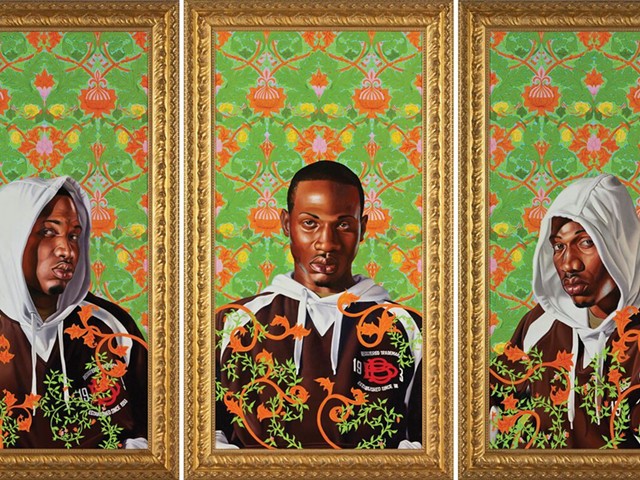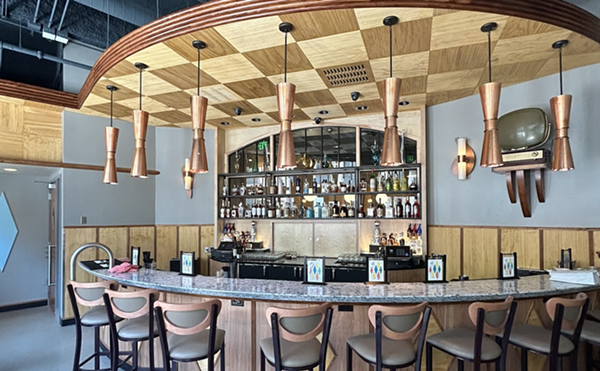As the Museum of Contemporary Art Detroit turns 9 years old, it remains true to its self-described mission "to present art at the forefront of contemporary culture." This season's lineup looks to be radical in nearly every sense of the term.
The exhibition "You Can't Print That: 50 Years of the Fifth Estate," which celebrates a half century of underground leftist work in print, already opened last week, Sept. 10, at Mike Kelley's Mobile Homestead. A giant, partially Kickstartered geometrically abstract and colorful façade mural, Andrew Kuo's "Living Canvas," is being installed by the New York-based artist along with local muralists as we go to press. And the ambitious group show "United States of Latin America," which opens Friday, Sept. 18 and was co-curated by Jens Hoffmann and Pablo León de la Barra, looks to be a major show of important, rarely seen, contemporary work.
A host of music, film, dance and lecture events are slated in their large performance space. Highlights just for October include Laetitia Sadier from Stereolab on Oct. 1, a Day of the Dead ofrenda on Oct. 3, a dance work choreographed by Adva Zakai on Oct. 14, and a release party for a book called Realizing the Witch on Oct. 28. Metro Times spoke with Greg Baise, a former MT contributor and current curator of public programs at MOCAD, about this year's highlights. First, we had to talk about the traffic on Woodward, though, naturally.
Metro Times: How is MOCAD weathering the mess on Woodward these days?
Greg Baise: We are doing just fine. Drivers around here are resourceful and seem to have no problem finding alternate routes or navigating the new parking meter system. Whoever thought it was a good idea to keep the meters going after six (and to limit meters to two hours) ought to be canned, though.
MT: In the mobile homestead, there's "You Can't Print That: 50 Years of the Fifth Estate." What can you tell me about this show?
Baise: Fifth Estate is the legendary underground newspaper founded by Harvey Ovshinsky in 1965 in the Cass Corridor. It started out as part of the '60s counterculture, but pretty soon took an anti-authoritarian bent. The show at the Mobile Homestead has a bunch of posters, leaflets, broadsides, and other ephemera, as well as some of the vintage tools they used to create this stuff. There's a sibling Fifth Estate show at the Detroit Historical Museum that's also open now.
MT: This "United States of Latin America" show looks like it took so much work to assemble. Just reading about what's gone into the catalog alone is impressive. So what can you tell us about this show?
Baise: Our senior curator at large, Jens Hoffmann, collaborated with Pablo Leon de la Barra, who is a curator at the Guggenheim, in creating this show. They've created a survey of contemporary work from Latin America, all from artists born post-1972, all from the Kadist Foundation, a progressive arts organization that's based in San Francisco and Paris.
Most of the work, if not all of it, contains political critique. One piece that hits pretty close to home is Clarissa Tossin's "Fordlandia Fieldwork," which examines landscapes in Detroit, Dallas, and Los Angeles alongside topographical images of Henry Ford's failed Brazilian utopia, Fordlandia. I love the opportunity that this particular exhibition brings. It presents contemporary artists that our visitors might not have access to otherwise.
MT: Beyond visual art, what other events are you excited about?
Baise: Personally, I'm excited about it all — it's a big deal for me to help bring talent from all around to Detroit, and establish connections. For instance, bringing in the wonderful Helado Negro only makes perfect sense when our current show is a survey of Latin American art. I'm also really looking forward to bringing Micachu and the Shapes here. That's a band led by Mica Levi, who is most well known for the soundtrack she made for Under the Skin.
We've also got three super book events. The greatly admired Wayne State art historian Dora Apel will discuss her book Beautiful Terrible Ruins, wherein she examines art images of Detroit through the lens of such antagonists as globalization and industrial disinvestment. Music scholar John Corbett will be accompanied by the titanic saxophonist Joe McPhee on Saturday, November 21, to read from Microgroove: Forays Into Other Music. Wayne State anthropology professor Todd Meyerswill talk about his new book about the brilliant and creepy film Häxan (Witchcraft through the Ages) on Wednesday, October 28th, and we'll be screening the film too.
MOCAD is open 11 a.m. – 5 p.m. on Wednesday, Saturday, and Sunday; 11 a.m. – 8 p.m. on Thursday and Friday; 4454 Woodward Ave, Detroit; (313) 832-6622; mocadetroit.org; suggested donation is $5.






